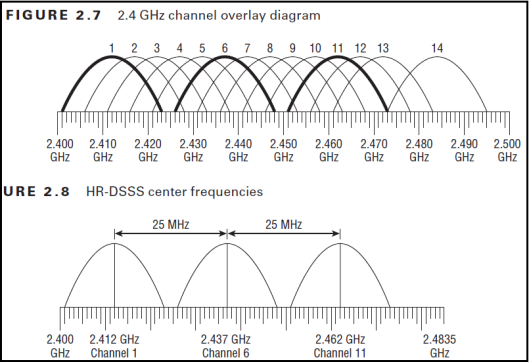2.4GHz (2.4000 GHz to 2.4835 GHz)
– 802.11 (FHSS clause 14 or DSS clause 15 radios)
– 802.11b (HR-DSSS clause 18 radios)
– 802.11g (ERP clause 19 radios)
– 802.11n (HT clause 20 radios)
In addition to being used by wireless networking equipment, 2.4GHz ISM band is also used by microwave oven, cordless phones, baby monitors, wireless video camera & other devices. According to 802.11 standard legacy DSSS channels had to have at least 30MHz of spacing between center frequencies to be considered non-overlapping. So CH1, CH6 & CH11 were considered as overlapping as they separated by 25MHz.
According to 802.11 standard legacy DSSS channels had to have at least 30MHz of spacing between center frequencies to be considered non-overlapping. So CH1, CH6 & CH11 were considered as overlapping as they separated by 25MHz.
Under HR-DSSS (802.11b) which states channels need a minimum of 25MHz of separation between center frequencies to be considered non-overlapping. So in 802.11b CH1, CH6 & CH11 are non-overlapping.
ERP-DSSS & ERP-OFDM (802.11g) also require 25MHz separation. So under 802.11g CH1 , CH6 & CH11 considered to be non-overlapping.
Transmit Spectrum Mask (DSSS & HR-DSSS)
– first side band frequency (-11MHz to -22MHz & +11MHz to +22MHz from center) must be at least 30dB less than the main frequency.
– any additional sideband carrier frequencies (-22MHz & + 22MHz from center frequency) must be at least 50dB less than the main frequency.
 Below shows the level of interference at particular level of signal reception level. It is important to separate AP,so that interference from sideband frequencies does not occur.
Below shows the level of interference at particular level of signal reception level. It is important to separate AP,so that interference from sideband frequencies does not occur.
 5 GHz (Unlicensed National Information Infrastructure – UNII bands)
5 GHz (Unlicensed National Information Infrastructure – UNII bands)
– 802.11a defined 3 UNII bands 100MHz wide each & 4 CH in each UNII band.
1. UNII-1 (5.150-5.250 GHz)
2. UNII-2 (5.250-5.350 GHz)
3. UNII-3 (5.725-5.825 GHz)
-802.11h (DFS & TPC) adds UNII-2 Extended 255MHz wide (additional 11 CH)
4. UNII-2 Extended (5.470 -5.725 GHz)
– The centers of the outermost channels must be 30MHz from the band’s edge in the UNII-1 & UNII-2 & must be 20MHz in the UNII-3 band.
– There are 4 non-overlapping channel in above 3 UNII bands with 20MHz separation between center frequencies.
– Centre frequency of each channel (eg 36,40,…100, ..161,165) can be calculated as (5000+5x N_CH) in MHz. Eg CH100 center frequency is 5.500 (5000+5×100)
 – IEEE does not specifically define a channel width for 5GHz, however the spectral mask of an OFDM channel is approximately 20MHz.
– IEEE does not specifically define a channel width for 5GHz, however the spectral mask of an OFDM channel is approximately 20MHz.
– Clause 17 OFDM, required only 20MHz of separation between the center frequencies to be considered as non-overlapping (hence all 23 CH are non overlapping)
 Adjacent Channel
Adjacent Channel
– Any channel with non-overlapping frequencies for DSS & HR-DSSS PHYs.
– First channel with a non-overlapping frequency space for ERP & OFDM.

